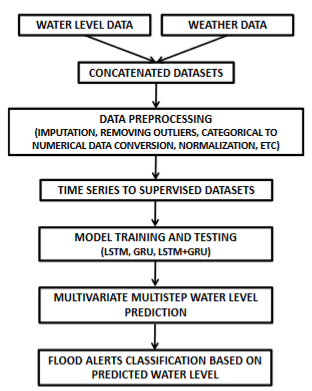Flood Prediction Based on Weather and Water Level Historical Data Using Recurrent Neural Networks: A Case Study of Jakarta Flood Incidents
Keywords:
Early warning system, flood prediction, gated recurrent unit, long short-term memory, recurrent neural networksAbstract
In spite of high sea tides in combination with subsidence cause floods in the northern part of the city, successive rainstorm along the year is considered as the decisive cause of flood incidents in the Jakarta area. Flood incidents can massively damage and inevitably disrupt most of social-economic activities of the city. Taking flood risk in many respects into account, a local flood early warning services (FEWS) as the integral part of the city flood comprehensive mitigation plan may be urgently needed. The capability of FEWS to provide a prediction of the scale, timing, and location of the impending flood may then be used to take city-wide precautionary steps. In this study, based on local weather and floodgate water level historical data, an attempt to develop a base model of such a FEWS using recurrent neural networks (RNN) is carried out. The local weather time series data is first concatenated with the floodgate water level data and it is then utilized to predict water level at the corresponding floodgate in 7 days ahead. The predicted water levels in turn are used to decide flood alert categories in the nearby areas surrounding the floodgates. Different types of RNN such as long short-term memory (LSTM), gated recurrent unit (GRU) and combination of LSTM-GRU are examined in order to get the best model capable of giving minimum prediction error. Our computational experiments show that all three models succeed to produce a considerable low prediction error on three different datasets with the stacked GRU model demonstrates its superiority compared to the other two models. The stacked GRU with 32 neuron each is capable of giving root mean square error (RMSE), mean absolute error (MAE) and mean absolute percentage error (MAPE) namely 109.73, 82.91, and 0.05 respectively on Marina Ancol floodgate dataset
Downloads
References
M. Garschagen, G. A. K. Surtiari, and M. Harb, “Is Jakarta’s new flood risk reduction strategy transformational?,” Sustain., vol. 10, no. 8, pp. 4–7, 2018, doi: 10.3390/su10082934.
Gill, D. R. . (2022). A Study of Framework of Behavioural Driven Development: Methodologies, Advantages, and Challenges. International Journal on Future Revolution in Computer Science &Amp; Communication Engineering, 8(2), 09–12. https://doi.org/10.17762/ijfrcsce.v8i2.2068
M. Arsyad, “Analisis parameter curah hujan trhdp fenomena perubahan iklim,” pp. 139–145, 2021.
A. Faruq, S. S. Abdullah, A. Marto, M. A. A. Bakar, Samin, and A. Mubin, “River water level forecasting for flood warning system using deep learning long short-term memory network,” IOP Conf. Ser. Mater. Sci. Eng., vol. 821, no. 1, 2020, doi: 10.1088/1757-899X/821/1/012026.
Kabisha, M. S., Rahim, K. A., Khaliluzzaman, M., & Khan, S. I. (2022). Face and Hand Gesture Recognition Based Person Identification System using Convolutional Neural Network. International Journal of Intelligent Systems and Applications in Engineering, 10(1), 105–115. https://doi.org/10.18201/ijisae.2022.273
M. Chhetri, S. Kumar, P. P. Roy, and B. G. Kim, “Deep BLSTM-GRU model for monthly rainfall prediction: A case study of Simtokha, Bhutan,” Remote Sens., vol. 12, no. 19, pp. 1–13, 2020, doi: 10.3390/rs12193174.
Krishna, P. R. ., and P. . Rajarajeswari. “EapGAFS: Microarray Dataset for Ensemble Classification for Diseases Prediction”. International Journal on Recent and Innovation Trends in Computing and Communication, vol. 10, no. 8, Aug. 2022, pp. 01-15, doi:10.17762/ijritcc.v10i8.5664.
M. Cho, C. Kim, K. Jung, and H. Jung, “Water Level Prediction Model Applying a Long Short-Term (LSTM)-Gated Recurrent Unit (GRU) Method for Flood Prediction,” MDPI, vol. 14, no. 2221, 2022.
D. E. Tarkus, S. R. U. A. Sompie, and A. Jacobus, “Implementasi Metode Recurrent Neural Network pada Pengklasifikasian Kualitas Telur Puyuh,” J. Tek. Inform., vol. 15, no. 2, pp. 137–144, 2020.
I. Cholissodin and A. A. Soebroto, AI , MACHINE LEARNING & DEEP LEARNING ( Teori & Implementasi ). Malang, 2020.

Downloads
Published
How to Cite
Issue
Section
License

This work is licensed under a Creative Commons Attribution-ShareAlike 4.0 International License.
All papers should be submitted electronically. All submitted manuscripts must be original work that is not under submission at another journal or under consideration for publication in another form, such as a monograph or chapter of a book. Authors of submitted papers are obligated not to submit their paper for publication elsewhere until an editorial decision is rendered on their submission. Further, authors of accepted papers are prohibited from publishing the results in other publications that appear before the paper is published in the Journal unless they receive approval for doing so from the Editor-In-Chief.
IJISAE open access articles are licensed under a Creative Commons Attribution-ShareAlike 4.0 International License. This license lets the audience to give appropriate credit, provide a link to the license, and indicate if changes were made and if they remix, transform, or build upon the material, they must distribute contributions under the same license as the original.





